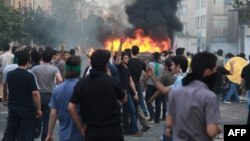Saeed Ghasemi, an outspoken Iranian political activist and veteran of the Iran-Iraq war, has equated the “culture of Daesh” (the Persian acronym for the Islamic State militant group) to the 2009 election protests in Iran.
The 2009-10 protests erupted in the wake of the announcement on June 12, 2009, that Mahmud Ahmadinejad had won the presidential election, amid allegations of widespread fraud. The Iranian conservative media refers to the protests as “fitna” (sedition).
Ghasemi said that the “fitna” of 2009 was “the same thing as IS culture.”
While Iran would be united in the face of a military invasion, “we do not do anything against a cultural invasion,” he warned.
Ghasemi said the “troublemakers” -- a reference to the protesters -- had taken Iran to the “brink of the precipice,” adding that Iran was still defending itself against the “fitna.”
He said “IS culture” is the factor that is now making young Iranians “distance themselves from principles” and which in 2009 had caused them to come out onto the streets with the intention of subversion.
Ghasemi’s comparison of IS with the “troublemakers” behind the 2009 antigovernment protests is not surprising. The Iranian leadership see the 2009 protests as an attack on the Islamic Revolution and its doctrine of “resistance,” while a number of figures in Iran, including the supreme leader, have accused IS of being “takfiris” (Muslims who refer to other Muslims as apostates) who are attacking Islam and Iran’s regional “axis of resistance.”
Expediency Discernment Council secretary and former Islamic Revolutionary Guards Corps (IRGC) commander Mohsen Rezaei, for example, said of IS last month that “the takfiris are betraying Islam.”
Ghasemi is not the first in Iran to compare the Islamic State group to the influence of alien and negative cultural values in Iran, particularly among young people.
In August, the conservative cleric Alireza Panahian, a representative of the supreme leader, compared the threat of IS to the “Westernization” of young Iranians.
-- Joanna Paraszczuk




